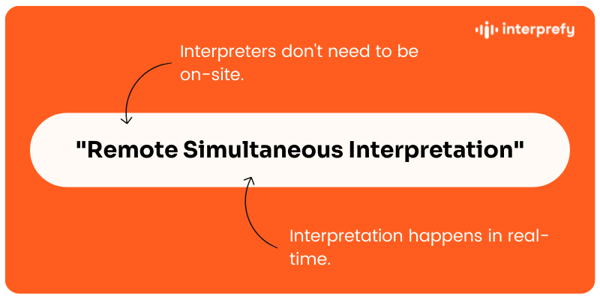Simultaneous interpretation (SI) is the process of conveying a speaker’s message from one language to another in real time. Unlike consecutive interpreting, where the speaker must pause to allow for interpretation, simultaneous interpretation ensures a seamless and continuous flow of speech. This makes it the preferred choice for conferences, live events, and multilingual meetings where communication must remain unbroken.
By eliminating interruptions, simultaneous interpretation enables global audiences to engage effortlessly, enhancing communication and accessibility across languages.
Simultaneous Interpretation: Remote or On-Site?
Simultaneous interpretation can be delivered through traditional on-site setups or modern remote solutions.
Traditional Simultaneous Interpretation Tools
Traditional simultaneous interpretation requires specialized equipment to ensure clear communication and seamless interpretation in real time. Key components include:
- Soundproof booths – Enclosed spaces that block outside noise, helping interpreters hear the speaker clearly and focus on their work.
- Interpreter consoles – Devices that let interpreters listen to the speaker and deliver interpretation in real time.
- Headsets and microphones – Ensure interpreters can hear clearly and speak without background noise.
- Transmitter and receiver systems – Send the speaker’s voice to the interpreter and deliver the interpretation to the audience.
- Wireless audio systems – Allow interpretation to be transmitted without cables, offering more flexibility for events.
While on-site simultaneous interpretation represents a familiar setup for many event organizers, it also comes with significant limitations. The need for specialized equipment, venue space for soundproof booths, and technical setup can drive up costs. Additionally, relying on in-person interpreters limits the available talent pool, as experts may need to travel—adding expenses for flights, accommodation, and logistics. For events requiring flexibility, cost-efficiency, and access to a wider range of language professionals, remote simultaneous interpretation (RSI) presents a modern, scalable alternative.
Remote Simultaneous Interpretation Tools
Remote Simultaneous Interpretation eliminates the need for on-site interpreters and equipment—reducing costs, carbon emissions, and the burden on event organizers. Essential RSI tools include:
- Online platforms – Enable interpreters to work remotely and deliver real-time interpretation without the need for on-site equipment.
- Reliable devices – A computer, tablet, or smartphone ensures access to the interpretation.
- Clear audio – High-quality microphones and headsets help interpreters hear and speak clearly.
- Strong internet connection – A fast and stable connection prevents delays or interruptions.

Having interpreters work remotely slashes costs while enabling greater flexibility for both interpreters and event organisers. RSI allows event organizers to access a wider pool of professional interpreters without the constraints of location, ensuring the best language experts for every event. It also removes the need for on-site booths and equipment, simplifying logistics and reducing setup time. Additionally, RSI is easily scalable—whether for small meetings or large conferences—making it an efficient and adaptable solution. When done right, Remote Simultaneous Interpretation is a modern and cost-effective way to make your next event truly multilingual.
With RSI simplifying multilingual communication, the next step is selecting the right platform for your event. Not all RSI solutions are the same—features like audio quality, security, ease of use, and integration with your event setup can make a big difference. So, how do you determine which platform best fits your needs? Here’s what to consider when making your decision.
How to Choose the Best Remote Simultaneous Interpretation Platform for Your Event
- Multi-Language Support – Ensure the platform can handle multiple languages at once for a global audience.
- High-Quality Audio & Video – Clear sound and visuals are crucial for seamless interpretation.
- User-Friendly Experience – A simple interface makes it easy for both organizers and participants.
- Reliable Connectivity – Low latency and stable performance prevent delays.
- Security & Privacy – Look for strong encryption and compliance with data protection regulations.
- Integration with Existing Tools – Ensure compatibility with platforms like Zoom or Microsoft Teams.
- Customization Options – Choose a platform that allows branding and personalization to align with your event.
- Recording & Playback – Having access to recorded sessions for post-event review or on-demand viewing adds long-term value.
- Technical Support – 24/7 assistance ensures a smooth experience for both organizers and interpreters.
Interprefy Remote Simultaneous Interpretation Platform
Interprefy stands out as the premier Remote Simultaneous Interpretation (RSI) platform, offering a cost-effective, flexible, and seamless multilingual solution for any event. By reducing interpretation costs by over 50% compared to traditional setups, Interprefy ensures accessibility without compromising quality. Its flexibility allows for last-minute press conferences and multilingual meetings, while eliminating the logistical burden of arranging interpreter travel and accommodation. With a hassle-free, bring-your-own-device approach, participants can tune in effortlessly, freeing up venue space and minimizing environmental impact.
Unlike other RSI solutions, Interprefy is not limited to online use—it can also be seamlessly integrated into on-site events. By working closely with LSP partners and clients’ AV systems, Interprefy customizes its platform to meet specific event needs, ensuring a smooth and high-quality interpretation experience. Whether hosting an event in a remote location or integrating with major platforms like Zoom, Interprefy delivers high-fidelity sound, low-latency performance, and unparalleled convenience. For a frictionless, professional interpretation experience backed by expert technical support, Interprefy is the ideal choice for making your next event truly global.
Discover Interprefy's use cases here.
Now you have a better idea how simultaneous interpretation works-especially remote simultaneous interpretation-, check out our other blogs for more information on how it can be used.
More resources:
- The ultimate guide to remote simultaneous interpretation
- A comprehensive guide to simultaneous interpretation
- The benefits of remote simultaneous interpretation
- How much does remote simultaneous interpretation cost?
Are you ready to remove language barriers in your meetings through remote simultaneous interpretation?


.webp?width=1040&height=800&name=Dayana%20%CC%81s%20Copy%20of%20Blog%20post%20template%20(2).webp)



 More download links
More download links



